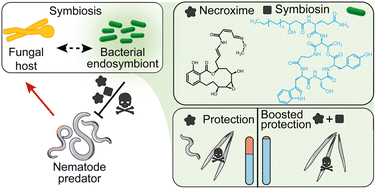Endofungal bacteria boost anthelminthic host protection with the biosurfactant symbiosin†
Abstract
Effective protection of soil fungi from predators is crucial for their survival in the niche. Thus, fungi have developed efficient defence strategies. We discovered that soil beneficial Mortierella fungi employ a potent cytotoxin (necroxime) against fungivorous nematodes. Interestingly, this anthelminthic agent is produced by bacterial endosymbionts (Candidatus Mycoavidus necroximicus) residing within the fungus. Analysis of the symbiont's genome indicated a rich biosynthetic potential, yet nothing has been known about additional metabolites and their potential synergistic functions. Here we report that two distinct Mortierella endosymbionts produce a novel cyclic lipodepsipeptide (symbiosin), that is clearly of bacterial origin, but has striking similarities to various fungal specialized metabolites. The structure and absolute configuration of symbiosin were fully elucidated. By comparative genomics of symbiosin-positive strains and in silico analyses of the deduced non-ribosomal synthetases, we assigned the (sym) biosynthetic gene cluster and proposed an assembly line model. Bioassays revealed that symbiosin is not only an antibiotic, in particular against mycobacteria, but also exhibits marked synergistic effects with necroxime in anti-nematode tests. By functional analyses and substitution experiments we found that symbiosin is a potent biosurfactant and that this particular property confers a boost in the anthelmintic action, similar to formulations of therapeutics in human medicine. Our findings illustrate that “combination therapies” against parasites already exist in ecological contexts, which may inspire the development of biocontrol agents and therapeutics.

- This article is part of the themed collection: 2023 Chemical Science HOT Article Collection


 Please wait while we load your content...
Please wait while we load your content...